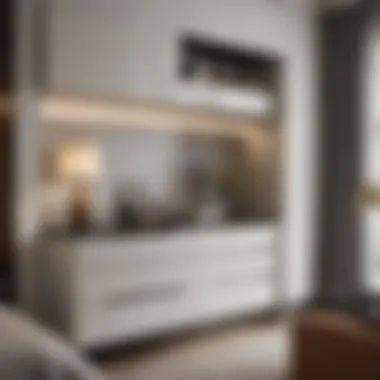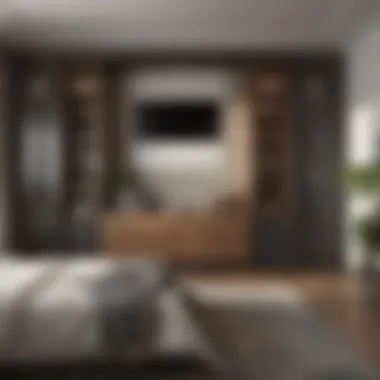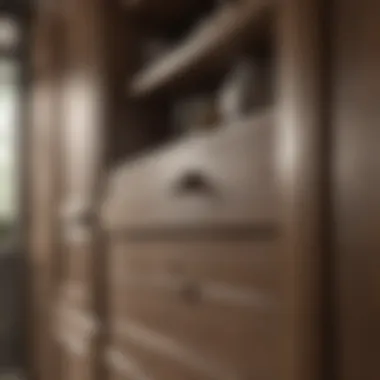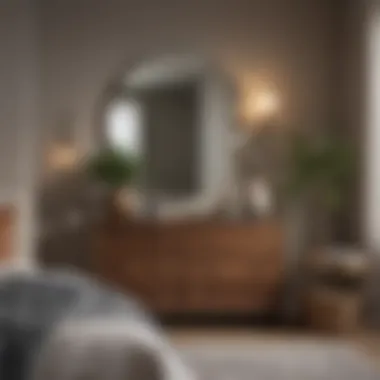Maximizing Bedroom Space with Elegant Built-In Cabinets


Intro
In the realm of interior design, optimizing space while injecting character can significantly transform a bedroom. Built-in cabinets epitomize this blend of functionality and aesthetic appeal. They are designed to blend seamlessly into architectural spaces, significantly enhancing storage capacity. As one might explore the multifaceted role of these features, it is essential to consider their various styles, installation processes, and the materials that will ensure durability.
Understanding the psychological advantages of organized environments is equally important. How our spaces are arranged can impact our mental well-being. Thus, embarking on the journey towards integrated storage solutions becomes pivotal for homeowners, particularly in high-use areas like the bedroom. This comprehensive guide is formulated to offer insights that will assist housewives and house owners in enhancing their personal spaces through the innovative use of built-in cabinetry.
Materials:
To begin the journey of creating built-in cabinets, a well-thought-out list of materials is crucial. Here’s a detailed breakdown:
- Plywood or MDF Sheets:
- Wood Screws:
- Wood Glue:
- Paint or Stain:
- Cabinet Hinges:
- Drawer Slides:
- Cabinet Handles or Knobs:
- Finish Nails:
- Backer Panel:
- Shelf Brackets and Plates:
- Which one: Use plywood for a robust option; MDF offers a smoother finish for painting.
- Measurements: Standard size 4x8 feet sheets; plan enough sheets as per cabinet design dimensions.
- Size: 1.25 inch and 1.5 inch screws for various assemblers.
- Type: PVA or Polyurethane glue for better bonding strength.
- As per preference for aesthetic finish, consider a quart or gallon size based on area.
- 105-degree or European style hinges for hidden doors, check quantity as per door count.
- Choose side-mount, under-mount or full-extension; keep in mind their weight capacity.
- Choose style, material, and quantity as desired.
- Mixed sizes for added trim and secure joining edges.
- Consider a thin plywood panel for the back, measuring as per cabinet unit voids.
- Based on design plan; typically use 2 to 4 brackets per shelf.
These materials will provide a sturdy foundation and beautiful finish necessary for ensuring a lasting and successful project.
DIY Steps:
Step 1: Planning
Begin by measuring the available space thoroughly.
This ensures that the cabinets fit seamlessly into the bedroom. Record measurements and visualize the design.
Step 2: Designing
Sketch a rough design.
Include both exterior and interior components.
Step 3: Cutting Materials
Utilize saws to cut the wood or MDF based on the design plan.
Ensure you wear protective earmuffs and encircle tools properly.
Step 4: Assembling Boxes
Join panels using wood screws and wood glue.
Step 5: Adding Doors
Install cabinet hinges.
Adjustments may be necessary for alignment.
Step 6: Finishing Touches
Paint or stain surfaces.
Allow ample time for drying.
Step 7: Install Shelves
Use shelf brackets as identified to support shelves within the cabinet.
Include proper labeling to aid organization — clear intent fosters ease of access.
Technical Aspects:


Tools Required
- Circular saw, drill, measuring tape, level, paintbrushes, and sandpaper.
Ensure all tools used are in good working order before commencing.
Timing Specifics
- Estimation can vary based on design complexity:
- Planning: 1-2 days
- Construction: 2-4 days
- Finishing touches: 1-2 days
Critical Techniques
- Keep various alignments constant while building.
- Apply screws in predetermined points for balanced structure.
- Double-check levels before any permanent assembly.
DIY Project Process:
Step by Step Installation
- Install Side Panels: Attach them first to ensure a stable base.
- Add Backing: Connect the back panel after confirming the unit’s square.
- Position Base Panel: Ensure stability and precision alignment for better structure while installing the base.
- Secure Shelving: Ensure all shelves lie level.
- Fit Doors Last: This ensures clearance is appropriately established for functional happenings.
Troubleshooting Tips:
- If doors don’t align properly, check hinges for adjustments.
- If wood split occurs, fill it with appropriate wood filler.*
Through patience and precision, these crafted cabinets will fulfil practical functions, addressing the aesthetic demands of any living space effectively.
Prelims to Bedroom Built-In Cabinets
Bedroom built-in cabinets serve multiple crucial roles in enhancing both functionality and aesthetic appeal of a living space. They are not merely storage solutions but rather integrated designs that complement the overall decor of the bedroom. Understanding their various aspects allows one to maximize their potential.
Design-wise, built-in cabinets can elevate the feel of the bedroom, offering a seamless appearance that contributes to a cohesive environment. Conversely, from a functional point of view, they can be vital for space management. Thoughtfully planned built-in cabinets store belongings efficiently, making the most of limited square footage.
Furthermore, built-in cabinets can also reflect personal style and taste. Homeowners can incorporate a variety of materials, colors, and finish options that correspond to their vision of a perfect bedroom. By doing so, these cabinets align with the decor theme seamlessly, thus maintaining an inviting atmosphere.
Overall, this article will comprehensively explore the multitude of benefits and considerations that come with bedroom built-in cabinets, unveiling their importance in creating a harmonious blend of functionality and design.
Defining Built-In Cabinets
Built-in cabinets are fixed cabinetry designed as part of the architecture of a room rather than freestanding, standalone furniture. Configured within walls or alcoves, they fit so snugly that they blend in seamlessly, adding value and elegance to a space. Often, people choose them for bedrooms due to their effectiveness for storage. They can accommodate various items, from clothing to books, keeping the area uncluttered and organized. The custom nature of built-in cabinets means they can be designed to suit any dimensional constraints and taste considerations of the homeowner.
Historical Context
The concept of built-in cabinetry has evolved over centuries. Originally utilized in ancient civilizations, built-in solutions provided both practicality and aesthetic enhancement to living spaces. In these earlier settings, built-ins were often rudimentary, serving basic storage functions.
As interior design developed, particularly during periods like the Renaissance, built-in cabinets became more ornate and stylistically complex. They reflected the prevailing art and architectural styles of the time. From then on, the use of built-in cabinetry became commonplace among the affluent as a means of displaying wealth, elegance, and sophistication.
Today, modern architecture does not compromise on aesthetics, leading to an innovative evolution of built-in cabinets. Thanks to advances in materials and craftsmanship, current designs can fulfill diverse lifestyle needs while also contributing to a sense of refined style. This long timeline showcases the enduring appeal and adaptability of built-in cabinets in bedroom settings.
Functional Benefits of Built-In Cabinets
The integration of built-in cabinets in bedroom design represents a strategy to harness nostalgic efficiency and contemporary flair. As interiors remodel into bespoke spaces, built-in cabinets provide essential features. They address significant issues related to spatial constraints in personal resting areas. A multitude of benefits categorizes the significance of these installations into practicality, organization, and visual appeal.
Maximizing Space Efficiency
Space can often be a rare commodity, especially in urban settings where square footage comes at a premium. A built-in cabinet can transform unused areas into remarkable resources for storage. Instead of clunky furniture taking up valuable space, built-ins fit snugly. Their tailored nature ensures that every millimeter of allocated area serves a purpose.
- Subtle Integration: Built-in cabinets evoke a seamless feeling. They become part of the room's architecture, optimizing functions without drawing attention away from the overall design.
- Vertical Space Utilization: These cabinets extend vertically, often incorporating shelving up to the ceiling. This method effectively uses vertical planes while keeping the floor clear.
"One of the primary advantages of built-in cabinets is their conformity to the unique layout of your room. Their design potential accommodates every nuance of your space, offering a truly personalized solution."
Enhanced Organization
Ensuring that personal items remain organized in a bedroom is crucial not only for aesthetics but also for personal peace of mind. A well-structured bedroom promotes mental clarity.
Each built-in cabinet frequently features leveled compartments which could significantly enhance storage opportunities:
- Customizable Sections: Sliding drawers and adjustable shelves allow for improved arrangement of clothing and accessories. This ensures easy access.
- Zoned Storage Options: Certain designs support niche categories which efficiently manage your possessions, whether they are seasonal clothes or special occasion shoes. Hence, bedrooms can evolve into serene retreats during relaxation time.
This ability to arrange various belongings with intentionality supports more than physical order. Remaining organized brings diligent aspects to one's lifestyle, inspiring productivity.
Improved Aesthetic Appeal
The visual aspect of living space cannot be overlooked, especially in a restful area such as the bedroom.
Built-in cabinets provide the opportunity to elevate the room's ambiance. Various styles of cabinet designs enhance the overall decor in the following ways:
- Cohesive Design: Builders tailor these units to match or contrast with existing room elements. As a result, expanding the home's aesthetic establishes a more refined presence.
- Luxury Customization: Implementing high-end materials can breed luxury feelings. Creative designs can woo charm into rustic themes or radiate sleek minimalism.


The solid link between storage methodology and visual enjoyment makes living spaces reflect homeowners’ character traits. Investing time in stunning yet cohesive designs transforms rooms cohesively.
Design Considerations
Design choices are crucial when it comes to built-in cabinets in a bedroom. Crafting a space that feels cohesive, functional, and visually appealing requires careful thought. Every element, from style to color, contributes to a beautifully designed environment that reflects personal tastes while maximizing usability.
Choosing the Right Style
Modern Minimalist
The modern minimalist style focuses on simplicity and functionality, devoid of unnecessary ornamentation. It emphasizes clean lines and open spaces, making it a popular choice for many homeowners. Key characteristics of this style include neutral color palettes, geometric shapes, and a functional layout. Minimalist built-in cabinets often include benefits like ease of cleaning and maintaining a clutter-free look.
One unique feature is the ability for modern minimalist cabinets to seamlessly integrate with walls. This blending creates a sleek appearance that promotes tranquility without overwhelming the space. However, a potential disadvantage can be the limited storage options when designs prioritize minimalism too highly.
Classic Traditional
Classic traditional cabinets evoke a sense of timelessness and warmth. They often feature rich woods and ornate detailing, classical moldings, and finished hardware. This style brings a feeling of coziness and maturity, making it well-suited for those looking to create a soothing bedroom atmosphere.
A significant advantage of classic traditional design is its adaptability; it harmoniously blends with various decor influences, enhancing overall aesthetics without feeling out of place. However, ornate designs might require more upkeep in terms of cleaning and maintenance than simpler styles.
Eclectic Mix
The eclectic mix offers freedom for personal expression. It allows for the combination of various elements such as colors, textures, and materials, creating a distinctive atmosphere that uniquely represents the homeowner's taste. Key to this style is variety; different patterns and forms can coexist beautifully.
One unique feature of the eclectic mix is its capacity to tell a story. By integrating different aesthetics and fibers, each inclusion enhances your space's individuality. Despite its attractiveness, an eclectic design may pose challenges in achieving visual harmony, which can lead to cluttered feelings if not executed carefully.
Color Schemes and Finishes
Once style has been determined, color schemes and finishes come into play, further defining the mood of the space. Choices range from light, airy hues to deep, saturated shades. Light colors can open a room, creating an optimistic and spacious feel, while darker colors offer intimacy and warmth.
Finishes also influence the appearance and durability of cabinets. A matte finish can provide a modern look, while a glossy one might evoke elegance. Selecting the right combination of colors and finishes is essential for achieving the desired result—both functionally and aesthetically. Each can dramatically alter the perceived room size and ambiance.
Choosing colors and finishes not only impacts aesthetics but also functionality and maintenance over time.
Installation Processes
Installing bedroom built-in cabinets is a critical phase that merges aesthetics with practicality. Understanding the installation process ensures not merely the physical placement of these cabinets but also the maximal functionality of the space. This section focuses on the steps and decisions necessary for efficient and effective installation, benefiting both novice and seasoned homeowners alike. A well-executed installation not only enhances visual appeal but also ensures long-term durability and ease of use.
Preparation Steps
Preparation lays the groundwork for a successful installation. Before installation begins, several specific elements should be considered to minimize potential issues. Sufficient planning can save both time and effort.
- Measure Your Space: Accurate measurements of the bedroom are essential. Check for vertical clearance and width. Built-in cabinets should fit seamlessly into their designated area without crowding the space.
- Establish a Design Plan: Sketch your layout. Consider how the cabinet will interact with existing elements such as windows, doors, and furniture.
- Select Materials and Hardware: Choose appropriate materials depending on aesthetics and functionality. Inspect hardware like hinges and sliding mechanisms to ensure they are suited for everyday use.
- Determine Electrical Needs: If you plan to include lighting within your built-in cabinets, assess any required electrical work ahead of time. This may involve consulting a licensed electrician.
Preparation is more than just physical metrics. It includes identifying your needs, like storage volume and psychological comfort derived from organization; this plays an integral role in choosing your cabinets’ structures and finishes.
DIY vs Professional Installation
When deciding about installation methods, factors like time, expertise, and budget come into play. Each approach has valid advantages and potential drawbacks.
DIY Installation
Pros:
- Cost-Effective: Handling the installation on your own can significantly reduce costs associated with labor.
- Personal Satisfaction: Completing the project can be rewarding, bringing a sense of accomplishment.
- Customization: You are in control of each detail, and adjustments can be made according to your vision.
Cons:
- Time-Consuming: Completing installation can take numerous hours, especially if custom adjustments are needed.
- Skill Requirements: Any lack of skills in carpentry or basic restoration could lead to errors and misalignments.
Professional Installation
Pros:
- Expertise and Efficiency: Professionals ensure that the installation is completed quickly and correctly, reducing stress on the homeowner.
- Warranties: Many installation services offer warranties that cover labor and materials, providing peace of mind.
- Quality Results: Professionals often have access to high-quality tools unavailable to the average homeowner, producing a polished finish.
Cons:
- Higher Costs: Professional services add to the overall expenses.
- Less Personal Input: Homeowners may have limited involvement if they choose an installer with strict adherence to their own design processes.
Weighing these factors will guide you toward the most suitable decision for installation. Whether opting for DIY techniques or collaborating with a professional, prioritizing preparation and foresight can bridge the gap between mere installation and a professionally crafted living space.
Material Choices for Built-In Cabinets
Choosing the right material is pivotal when it comes to the design and functionality of built-in cabinets. Each material offers distinct advantages, influencing durability, appearance, and maintenance needs. Knowledge of available options shapes a homeowner's choice and experience as they plan their bedroom cabinetry. Thus, this section delves into commonly used materials while highlighting their unique attributes and any trade-offs involved.
Wood Options
Solid Wood


Solid wood is often considered the gold standard for furniture and cabinetry. Its various species, such as oak, maple, and cherry, not only offer durability but also an appealing natural aesthetic. The grain patterns and rich textures of solid wood can enhance the overall design of a room.
The key characteristic of solid wood is its sturdiness. The composition allows it to withstand weight and wear over time, making it a reliable choice for long-term investments. However, but its higher cost generally makes it a premium option that may not suit everyone's budget.
Solid wood carries a unique feature: the potential for refinishing. Over time, wear and tear can make furniture look dated. Solid wood can be sanded and refinished, restoring its former glory. This is an invaluable trait as it contributes to sustainability. On the flip side, solid wood can be susceptible to changes in humidity and temperature, which can lead to warping.
Engineered Wood
Engineered wood, made from layers of wood veneers and resins, is another popular choice in built-in cabinets. Its main appeal lies in its affordability and versatility. Unlike solid wood, engineered wood offers a variety of finishes, aligning well with modern design trends.
One key characteristic of engineered wood is its stability. This material resists fluctuations in moisture and temperature better than solid wood, making it ideal for fluctuating environments. It offers less maintenance worry for the homeowner.
Moreover, engineered wood has an interesting feature: it often carries environmental credentials. Many products are made from recycled wood fibers, making them a more eco-friendly option. However, while it is strong for construction, it may not match solid wood in longevity. Once damaged, engineered wood cannot be sanded or restained in the same manner as its solid counterpart, providing fewer long-term repair options.
Metal and Glass Alternatives
Another category includes metal and glass alternatives for built-in cabinets. These materials can deliver a contemporary look and vary significantly from the traditional wooden style.
- Metal: Frequently used in modern and industrial designs, metal integrates strength with minimalist aesthetic. It is often resistant to wear and tear, but may require frequent cleaning due to fingerprints and smudges.
- Glass: Glass-front cabinets can create a visually airy feel great for displaying cherished items. However, maintenance needs can be higher due to potential dust accumulation.
Durability and ease of care remain at the forefront of choice considerations. Selecting the right material ultimately reflects personal style preferences and functional needs for cabinetry in the bedroom.
"Once all elements are weighed, a well-informed decision enhances both the functionality and appeal of bedroom built-in cabinets. It relates directly to the improvements one visualizes for personal space."
Psychological Impact of Organization
The arrangement and organization of one's living space significantly affects mental well-being. Bedroom built-in cabinets serve not only as functional storage solutions but also play a critical role in influencing emotional and psychological comfort. By carefully managing space and promoting order, these cabinets contribute to a more serene and composed environment.
Effects on Mental Well-Being
A well-organized bedroom, facilitated by built-in cabinets, can have profound benefits on mental health. When clutter is minimized, many individuals experience a sense of relief and clarity. This directly relates to the ease with which people can find items when needed. Instead of rummaging through piles of clothes or accessories, turning to a neatly categorized cabinet reduces stress levels and enhances focus.
Studies suggest that a tidy environment promotes mindfulness, allowing for easier relaxation and mental restoration. The layout of built-in cabinets can encourage a calm state of mind simply by their physical presence paired with their supportive role in everyday tasks. When less time is wasted on searching and more time is dedicated to rest or productive activities, overall satisfaction increases.
- A few benefits include:
- Reduced anxiety levels.
- Improved ability to concentrate.
- Enhancement of overall mood.
Creating a Calming Environment
A clutter-free bedroom is essential in creating a tranquil atmosphere. Built-in cabinets allow for effective organization, enabling residents to establish sanctuaries from the chaotic world outside. This environment fosters feelings of safety and contentment.
Selecting design and placement carefully is critical. Choosing soft colors for built-in cabinets that blend with the walls can lend a sense of peace to the room. Adding lighting elements inside cabinets can also enhance depth and create an inviting ambiance.
Maintenance and Care
Maintaining built-in cabinets is fundamental for preserving their functionality and aesthetic appeal over time. A regular maintenance routine ensures that these cabinets serve their purpose effectively and remain a significant feature in bedroom design. Proper care can also prevent costly repairs or replacements, making it an essential aspect for homeowners.
Cleaning Guidelines
Keeping built-in cabinets clean is crucial not only for appearances but also for longevity. The right cleaning techniques can help avoid damage to the materials used in cabinetry.
- Dusting: Use a soft, microfiber cloth to dust the surfaces regularly. Dust can accumulate and scratch the finish if not cleaned consistently.
- Avoid Harsh Chemicals: When it comes to stains or marks, it's vital to use cleaning solutions that are gentle. Harsh chemicals can damage the finish or discolor the wood. A solution made of mild soap and water is often effective.
- Wipe Spills Immediately: Accidents happen, and spills should be dealt with promptly. Use a damp cloth to clean any liquids to prevent staining or warping.
- Maintenance Products: Consider using products designed specifically for maintaining wood surfaces. These may offer extra protection from humidity and temperature changes.
Long-term Care Tips
Long-term care of built-in cabinets extends their life and ensures a continual enjoyment of their benefits. Managing environmental factors and performing occasional inspections can make a significant difference.
- Check for Moisture: Bedrooms may experience changes in humidity, especially if a bathroom is nearby. Regularly inspect cabinets for signs of moisture damage, such as peeling or discoloration.
- Adjust Hardware: Periodically check the cabinet hardware. Tighten any loose screws on doors or drawer pulls to prevent unnecessary stress on joints and hinges.
- Seasonal Treatments: Depending on the material, consider applying seasonal treatments. For example, wood cabinets benefit from occasional polishing to nourish the wood and enhance its appearance.
- Professional Help: For larger maintenance issues, consulting a professional can save time and prevent comprehensive damage. Their expertise can catch what you might overlook.
Investing time into the maintenance of your built-in cabinets not only prolongs their life but also ensures they continue to enhance your bedroom's appeal and organization.
Routine maintenance and careful cleaning can significantly influence how well woodworking and finishes hold up against wear and tear. A small effort now can lead to enduring benefits alongside the beauty and functionality built-in cabinets bring.
Epilogue: The Lasting Value of Built-In Cabinets
Built-in cabinets represent more than just a stylish storage solution; they embody a commitment to maximizing functionality and enhancing the atmosphere of personal spaces. Through careful planning and execution, these cabinets create a seamless blend of utility and design. The implications of incorporating built-in cabinets extend to various aspects: from spatial efficiency and organizational prowess to aesthetic elevation. Each of these elements strengthens the case for investing in custom cabinetry.
Return on Investment
The return on investment for built-in cabinets usually exceeds initial expectations.
- Increased Home Value: Properties harmonized with well-crafted built-ins often attract more potential buyers. A well-designed cabinet enhances a room’s usability and its perceived value.
- Durability: High-quality materials lead to longevity. Investing once in superior components will reduce long-term expenditures in maintenance and replacements.
- Energy Savings: Adequate organization reduces clutter, aiding in climate control and promoting a well-structured living environment.
Research indicates that homeowners can expect returns of up to 70% on their expenditure when they integrate custom cabinetry in high-traffic areas. Smart design translates into functional gravity in potential market value.
Final Thoughts
In summation, built-in cabinets are versatile solutions that adapt modern design sensibilities for the functional needs of daily living. Their lasting value lies deeper than performance or aesthetics; it stimulates a harmonious environment encouraging clarity and calm. Deciding to incorporate them necessitates thorough research and thoughtful consideration of personal needs and space.
Embracing built-in cabinetry signifies a holistic approach to home design—one that blends innovative usage, lasting quality, and undeniable elegance. In achieving a tailored solution, one elevates the living experience, cultivating a sense of pride in one's environment and ultimately reaping benefits for years to come.
"A well-organized space promotes well-being and enhances productivity, thoughts shaped by how cabinets affect one’s day-to-day living."
As you reflect on your options, consider what unique style, material, and inset hue will complement your bedroom—addressing both function and personal joy. The journey to a well-organized and appealing space is yours to embark upon.







